The quality of 100 Hands shirts
Back in April I wrote my first post on shirtmaker 100 Hands, having visited their factory in Amritsar, India.
I argued that the important point to address first was that making in India involves no necessary compromise on labour conditions, skill or quality. That although issues exist in parts of India, generalising about such a huge country is always misleading.
I only mentioned the actual quality in passing, however. Here I’ll run through and illustrate the work that goes into them, in order to flesh out that point - again, drawing on first-hand experience of my visit.
India has a strong tradition of fine embroidery. Much of the world’s embroidery is outsourced here, and many families have heirloom pieces that are examples of the work.
Akshat at 100 Hands (centre, above) showed us one kashmiri piece of his mother’s that took one person almost two years to embroider - and a piece of ‘phulkari’ (a type of cross-stitch) that women in Amritsar specialise in.
“Most of the workers here have some experience of embroidery or hand stitching, learnt from their family,” says Akshat. “The challenge is to get them to do it more consistently and more efficiently.”
That’s where Akshat’s background comes in helpful. A software engineer previously, he has created several systems for managing production, including an online tracking system that allows him to see where a shirt is at any time.
“Given we live in the Netherlands now, I'd also like to think the factory is managed more along northern European lines,” he says. “Efficiency is the name of the game.”
The head of pattern cutting (above) has been fitting shirts for 45 years, and works with a team of four, two of whom are trainees (there is an unusually large number of trainees around the factory - a good sign for the future).
Next to him are two tables of cutters, nine people in total. One of Akshat’s early changes was to make sure all shirts flow in a single direction, stage by stage, rather than going to whomever was free at the time.
The next stage is cutting the fusing, to go in the collars, cuffs and plackets (above). 100 Hands do offer floating linings as well, but only a handful of English customers ask for it.
These fusing pieces are all cut individually alongside the cloth - nothing is cut in multiples. And they are all attached to the cloth with hand ironing (below), rather than pressing in a machine.
“You’re much more likely to get a collar fraying when the fusing has been pressed by machine,” says Akhsat. “It’s one reason fused collars have a bad reputation with some people.”
(I agree, as someone who wears pretty much only fused collars. Preferences for floating linings are often based on experiences of very cheap high-street shirts.)
Cutting the fusing by hand alongside the fabric also cuts down on problems later on. The pieces are much easier to stitch to the body of the shirt, reducing wastage.
“I get a little obsessed with these wastage statistics,” admits Akshat. “There are a lot of spreadsheets! We aim for 0.5% rejected shirts, where other factories would look to 1% or 2%.”
Another element that helps there is re-ironing. “We iron after every stage of production. It takes a lot of time, but it’s amazing how much easier and more consistent it makes the work,” says Akshat, reminding me of a very similar conversation with Ring Jacket in Japan.
He offers to show me the difference in numbers. I suggest we move on to the sewing.
There aren’t many sewing steps that it’s useful to do by hand, but the armhole is certainly one.
It enables the sewer to gather more fullness of the sleeve into the armhole - and anyone familiar with bespoke tailoring will know how a small armhole and large sleeve means freedom of movement.
This doesn’t mean that the sleeve is only attached by hand, however - it would be too weak. Rather, it is attached first by hand, gathering up that fullness, and then sewn over the top by machine to add strength.
It should be added that 100 Hands don’t sew the whole armhole by hand, even the first time, just part of it. “We find that’s all that’s needed to gather the fabric in,” says Akshat.
He also argues that too much attention is often paid to hand sewing: “We find hand cutting and pressing makes more of a difference to quality, to be honest. The problem is, you can’t see that so obviously, so people focus on hand stitching.”
That stitching is lovely, though.
This is where the embroidery heritage comes into its own, with the women (it’s mostly women; machine stitching is largely men) using a thinner needle than normal - the size they’d use for traditional embroidery work.
As a result, the buttonholes have over 100 stitches per inches, where others would have 40 or 60. And each one takes 35-40 minutes to do.
“It’s a luxury to be able to take this time over each buttonhole,” says Akshat. “If we were doing this work in Europe, we’d probably have to charge twice as much per shirt, given the time it takes.”
Of course, hand sewing the buttonholes and buttons is largely aesthetic, rather than functional, and this is particularly true of hand-stitching the side seams and bottom edge.
I’ve covered a few companies over the years that hand-sew that bottom edge - rolling it like a handkerchief - including Kiton, Luxire and D’Avino. I’ve also seen examples from others.
But 100 Hands seems the finest. Below, you can see their work (top) compared to D’Avino (middle) and Luxire (bottom).
Other areas of fine work include the actual embroidery for monograms and crests, which is beautiful, as you’d expect.
And the use of traditional techniques on fancier shirts.
Below, for example, a craftsman is hand-embroidering the whole front of a tuxedo shirt, with tiny crosses that intertwine.
This uses a different embroidery technique, with a long hooked needle. The hook enables the sewer to pull the thread back through the fabric, where normally they would have to pull it through by hand underneath, and then insert it upwards again.
These two panels, which will take 2-3 days to complete, are for a dress shirt for a certain well-known bespoke cutter.
100 Hands offers different product lines, which it’s important to outline.
There are two for quality, Black Line and Gold Line, and then different levels of fit.
The Black Line has all the steps outlined above except the hand sewing of the side seam and bottom edge. So: individual hand-cut fabrics, hand-matched patterns and individual hand-fused collar and cuffs, as well as semi-hand-sewn armholes, hand-sewn collars (inside and out), and hand-sewn front placket and gussets.
The Gold Line adds a lot more hand-sewing: of the bottom hem, the side seams, the sleeve plackets and the embroidered buttonholes. Making a Gold Line shirt takes around 35 hours.
There are then three types of fit: ready-made, made-to-measure and bespoke. The made-to-measure is sometimes referred to as semi-bespoke as it still involves an individual pattern. It is what the various stores and stockists offer; bespoke is something Akshat himself is starting to offer through trunk shows.
Prices vary between retailers, but are roughly £239 for Black Line RTW, £259 for Black Line made to measure, £319 for Gold Line RTW and £ £329 for Gold Line made to measure.
Stockists include Pauw Mannen in Amsterdam, Lund & Lund and Linnegatan 2 in Sweden, Mercken in Belgium, The Rake online, and Isetan, United Arrows and Barneys in Japan.
The prices are high for RTW or made-to-measure shirts, but as I’ve outlined, every Line involves a huge amount of work.
Bespoke is an interesting area, as it’s something Akshat is learning to do himself. I recently had a bespoke shirt made by him (fitting below, in India) and will cover that separately too at a later date.
Thanks again to Akshat, Varvara and everyone else for your hospitality when we visited.
The children have been talking about the coconuts and swivel chairs ever since.
Simon


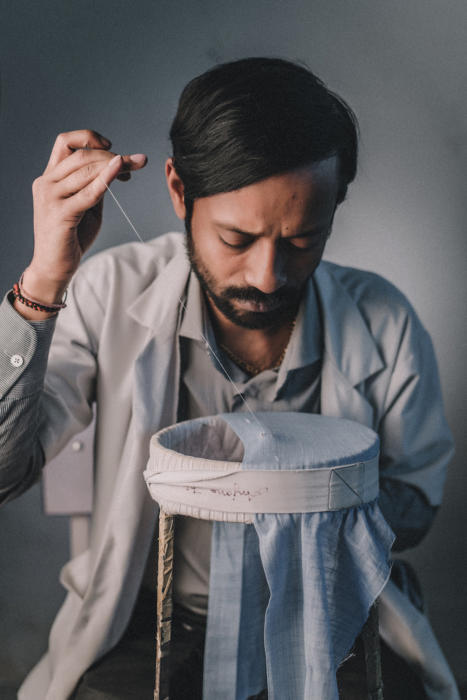
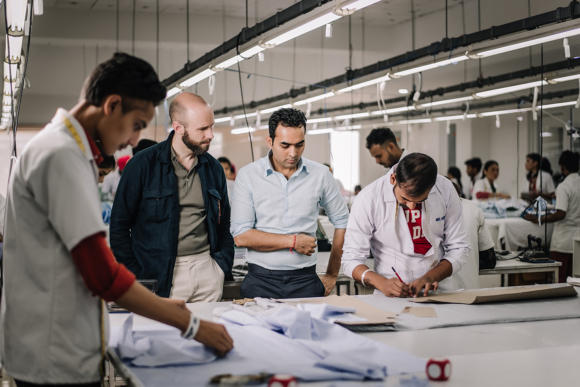
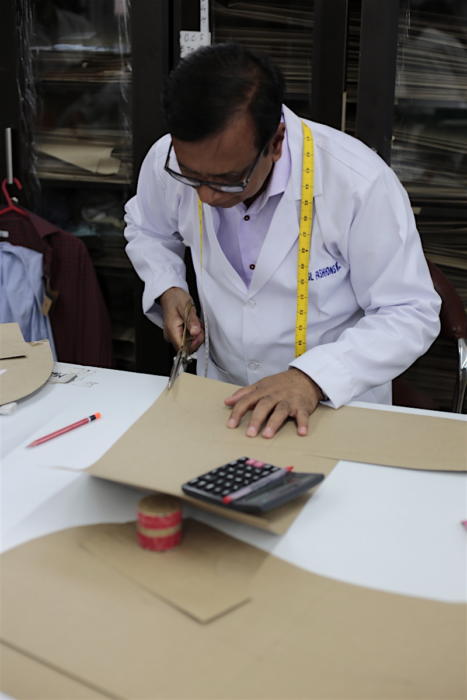
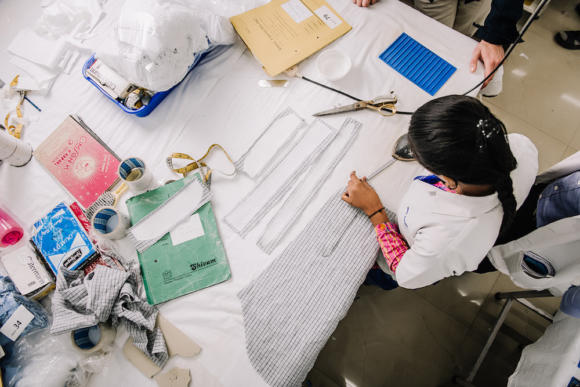
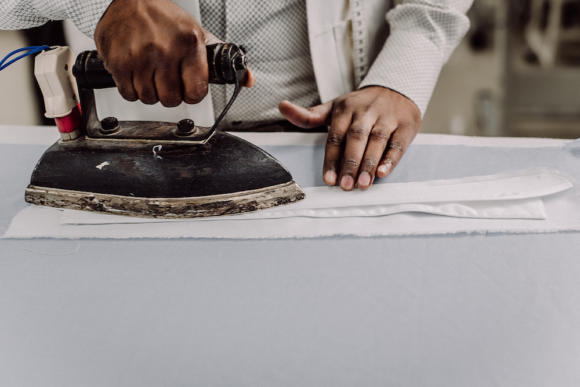
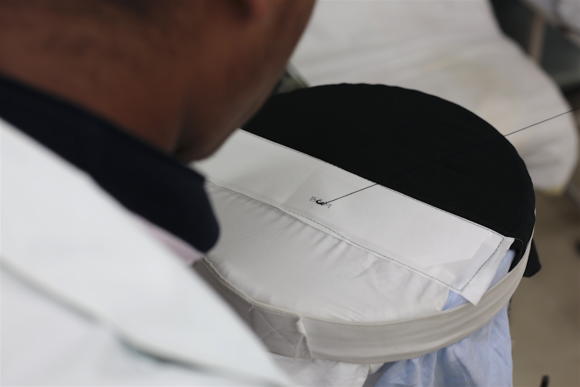
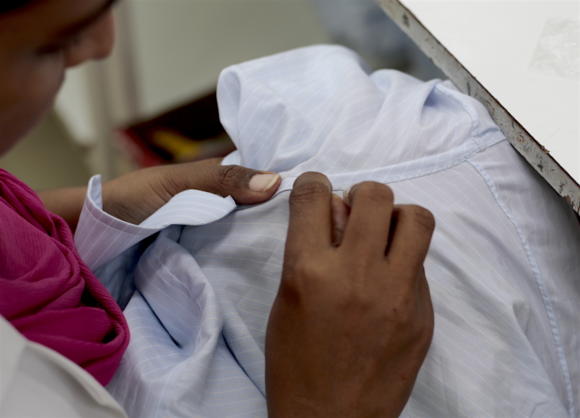
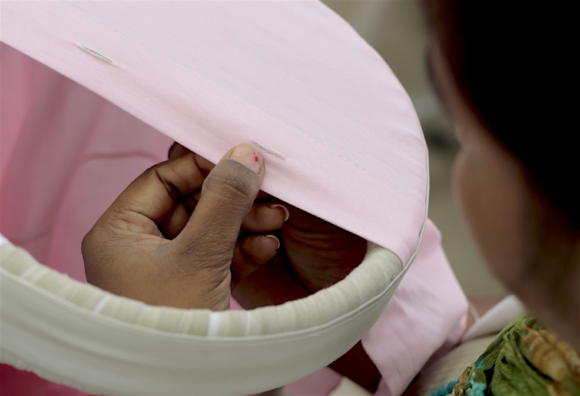
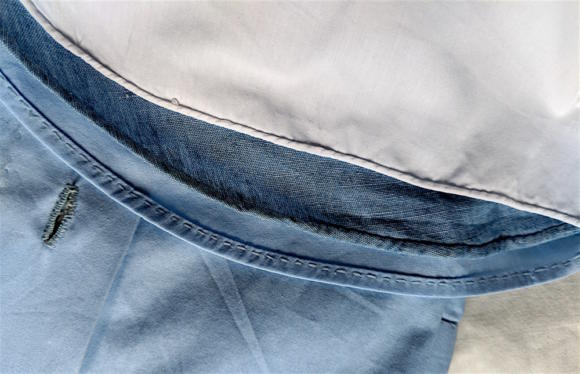
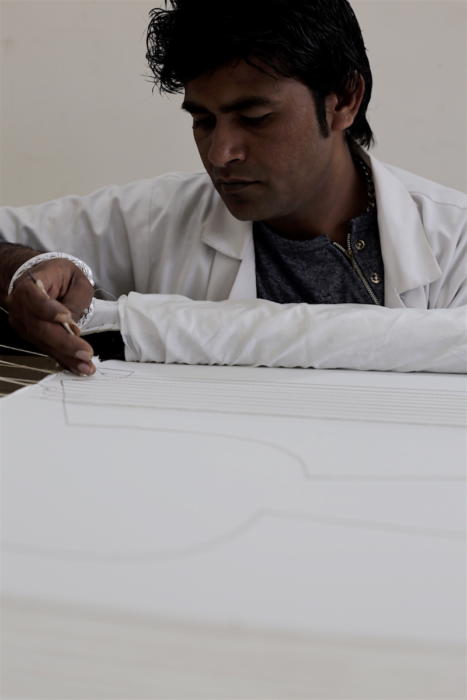
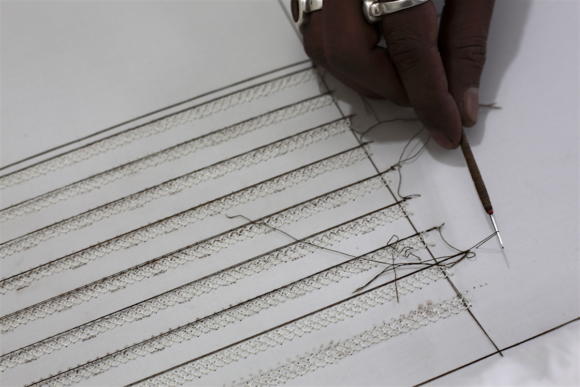
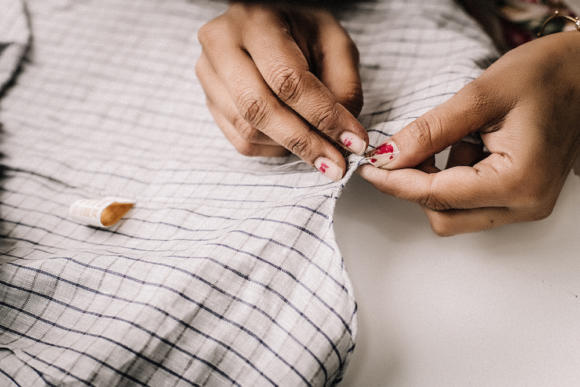
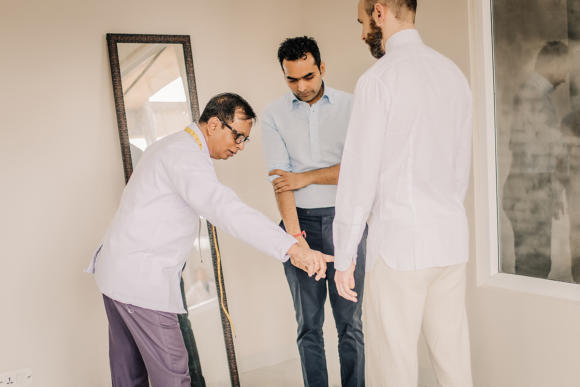


























Hi Simon. Perhaps this has been discussed to death or I’ve missed a post/discussion elsewhere on here, but why is it that you have used fused instead of floating lining on your shirts? Thanks.
It has been discussed elsewhere, but not on a dedicated post. I prefer fused because it is a little cleaner and sharper when the collar is buttoned, and (more importantly) rolls naturally around the jacket collar when unfastened, and can even be manually rolled a little into that shape. I don’t find floating collars more comfortable or better lasting either
Great article Simon. Wanted to know more about 100hands for a long time. I’ve noticed one thing seeing the last picture. The waistdarts. Is it something inevitable in MTM and bespoke in terms of the fit? Or is it possible to cut the fabric in a way that you have nice waist supression? Just wondering because I have quite a hollow back as well and always need waist darts in RTW
No, you can cut shape without the waist darts, just not quite as much, and not in the same place exactly. How well it will work for you will depend a little on your figuration.
A good outline of the production process. Also a skilled use of the ‘half concealed qualification’ wherein you list labour conditions, skill and quality but deftly avoid wage rates. Remuneration is the thing we ignore most in our neo-colonial relationships. I also suspect post hoc ergo propter hoc…’issues exist – generalising is misleading’ – you don’t have to make excuses about nationality of origin. The issues to consumers are simple; are people treated properly, are conditions fit and proper, are they properly paid (even by Western standards). Having said that luxury brands are selling (2018 season) nylon short sleeve shirts (made in Italy) for prices upwards of £500. The modern calculation of value therefore seems to sit outside of such simple things such as numbers.
Interesting points. The workers are paid well by local standards. Do you think they should be paid UK wages?
May I wade in? I think shirts should be made in the UK. But that’s just me.
Also, none of the issues mentioned by Anonymous really matter to consumers. If they did, Apple wouldn’t exist. Their factories are virtual prison camps, and the workers are the modern-day version of slaves.
I really do think all that matters is the price. The execs and owners of high-street brand are making indecent piles of money selling us tat made in sweatshops, at inflated prices.
Interesting, as there may be a Modern Slavery Act issue if the shirts were being bought to supply UK retail, but as they are being commissioned by an individual it would have no application.
Then it really is down to conscience.
I presume you’re not referring to the 100 Hands shirts Nick? The workers there are better trained, treated and looked after than any British factory I’ve ever been to…
No, absolutely not, Simon. More a general response to the comments from Robert and Anonymous.
Thanks
I’m not sure that I agree that the only thing that matters is price.
Provenance is important for a lot of people.
Personally, I buy British whenever I can and take pride in doing so.
I subscribe to the view that supporting my fellow citizens is my number one priority and that we can only help those less fortunate if we stay fit for fight.
For me, the less British content there is on this site, the less interesting it becomes and I’ve certainly zero interest in having my UK bespoke copied by tailors in far away places at half the price.
It is a complex debate and certainly I have garments in my wardrobe from Italy and France but nothing makes me smile more than seeing a UK company thrive. I love what Private White are doing and I think their explanation of their pricing policy is clever and accurate. I hope they do well.
As someone from India and quite familiar with the industry here, when you talks about wages without talking several other economic factors one missed the point. Wages in India is going to be much lower than the UK or Netherlands but so are costs of living. For example if onions go close to €1 a kilo its often a cause for the Government to topple! Only at the high end and luxury segments is India more expensive than the west but then you are strictly talking about disposable income. The skilled labour marker is also much more supply than demand so i am sure the tailors and cutters there are better of employed than not. There are indeed some sweat shops but it is unlikely that a company that focuses on skill and quality will employ one of those- labour laws in India are actually quite stringent once you are in the organised sector (you cross a minimal threshold of workers – about 20)..
For the number of hours and handwork that go into a shirt, I don’t find the price to be that unreasonable. But I’d still rather have my London-made bespoke shirts for less than the Black Line RTW, even if they are entirely machine-made.
While I prefer my collars and cuffs sewn rather than fused, I can see the appeal of a fused collar. But I have never found fused double cuffs to fold as nicely as sewn. Are there special techniques for making good fused double cuffs?
Good question Matt, I don’t know. Something to look into
Fused linings will always be stiffer than infused, even if only marginally, so yes a double cuff is not going to fold as nicely if fused.
Now when you have tried 100 Hands for a while. How do you compare the quality to your shirts from dÁvino and Luca Avitabile?
Quality is very similar to those (though I’ve only actually had one for about three months so can’t quite fully compare). Quality as in how it wears, how it feels. Fit isn’t perhaps quite as good, but then this is a first shirt. And finishing is obviously extremely good, as described here, but depends whether you count that as a part of ‘quality’ or not
You should visit Pakistan then you will have more variety of clothing. I and my dad recently visited Faisalabad, and we were so impressed.
Thanks. I have actually Thomas – I travelled in my youth all across China, across the Karakoram Pass and down the length of Pakistan.
Still have some slightly dodgy wool garments from there….
Do you mean the Khunjerab Pass and then down the Karakoram Highway or did you cross the Karakoram Pass before it became a largely inaccessible conduit between China and Indian-held territory?
As for wool garments from Pakistan I’ve found over the last couple of winters that a Chitrali cap can be combined rather wonderfully with a waxed cotton jacket or a tweed coat as an alternative to a flat cap or a watch cap. It’s remarkably flattering and with Western clothes almost no one will associate it with Pakistan (or Afghanistan, whose mujahideen made them famous in the 1980s). They come in beautiful earthy tones and can be had for next to nothing.
Sorry yes you’re right – Karakoram Highway.
Interesting on the cap, I didn’t try one of those
Simon,
Very interesting article, which raises my curiosity on a few issues.
The high – end clothing industry exists in Italy, and the U.K. based upon local taste and demand (note, I am not referring to the fact that in much of the developing world, there is a village based manufacture of basic clothing, owing to the fact externally manufactured goods are too expensive). I presume there is a local demand for high – end Indian clothing of western style.
Perhaps most importantly, what would be the domestic pricing of these clothes, relative to what a Western customer would pay?
We have all seen that rock-bottom pricing for suits and shirts in places like Asia have issues regarding fit, and quality (I believe one of the highly publicized on-line shirt makers recently shut down owing to a very percentage of shipments were of unacceptable quality), I find that the prices you quoted, don’t particularly impress me as being excellent value……does the quality truly justify the price?
I look forward to your comments..
I think the quality here does, yes,though as with anything it depends what your want to pay for – I completely understand others that want just strong, precisely machine-finished shirts.
I don’t know anything about the domestic prices of clothing in India I’m afraid
In response to your question it’s hard to mandate wage increases in another country but 100 Hands are using the fashion RTW model of low labour costs and western high final price. The difference is that the artisanal skill and attention to detail results in a final product of the highest quality. Robert makes some interesting points re. consumers but in bespoke the buyer has a much more personal, involved relationship. Matt S points to London bespoke being similar in price to 100H but clearly with a significantly higher cost base (London rates and rents are the world’s highest). If 100H incur perhaps 10% of this, why then, on balance, couldn’t wages be on a par with the UK? Perhaps it is argumentum ad lazarum but there seems to be an imbalance when third world wages make products that attract the highest of first world prices. As a suggestion if 100H were to announce that wages were a certain % of the product, proportionate to UK/western levels (profits sustained by the much lower overallcost base) it might nullify possible criticisms and buyer hesitation.
Interesting, thanks.
Personally, I value the other aspects of what 100H provides, like education, training, housing, health insurance, rather than wages that are just higher than those already rather above local rates.
The comparison with other fashion RTW is also not necessarily that accurate as a far higher percentage of the product cost is spent on manufacturing compared to them, and a lot less of marketing and design
A tad naïve.
Its already been established that by comparison with the market, 100H are offering a far better package. Offering wages at western levels is not a serious option.
As to price, a well structured business prices to its market. That’s why much is cheaper in the US than its UK equivalent.
Simples.
You cannot be serious. This is naive reasoning at best.
First of all, any bespoke shirt does not come close to what 100 Hands offers in terms of craftsmanship or time spent working on the shirt. They could obviously offer UK wages but that would imply paying 1500 EUR for your shirt. Do you think anybody in their right mind would do so? I don’t.
Simon,
Are there any plans for U.S. visits?
Am I right in thinking Turnbull & Asser put a floating lining in their shirts? Also, does the 100 hands choice of fabrics extend to Sea Island and two fold cottons?
Yes and yes
100 Hands simply delivers the best work I have seen so far with shirt makers. I have tried, like you but probably less than you, many different shirt makers and 100 Hands has the finest work one could hope for.
I am also quite happy with the fit and the collars we have developed are truly perfect for me.
The level of craftsmanship involved in each buttonhole is second to none as you’ve pointed out. I have had heated arguments with bespoke enthusiasts who objected that quality garments could not be made outside of the UK, France or Italy. This is ludicrous and makes me want to spend my time with people who have better working brains, or an open mind at the very least.
Thank you Simon for shedding some light on Akshat’s and Varvara’s efforts. They do deserve some praise.
Nice to have your personal experiences – thanks Paul
I accept 100H quality. I accept the pricing (it could be higher). I do question the remuneration of the artisan. Simon you have avoided this point throughout. It’s a pattern seen elsewhere in PS whenever developing nations come into focus (cardigan-gate etc.). A neo-colonial representation is often given but it’s a moral vanity to seek the finest clothing yet beggar the maker. To talk about other worker benefits is therefore a paternalistic sop. As 100H are judged to be the best (many positive comments) why not pay the true value? Why do we expect lower pricing on an item and short change it’s maker because they’re Indian and look up (and pay more) because it comes from a western fashion brand (where we think the maker is better paid)? It’s a form of casual racism hidden in ‘market economics’.
Checked on Punjab wage rates (100 Hands are in Amritsar) on paycheck.in. Minimum wage for highly skilled (highest category) garment worker is 406 Rupees per day…that’s £4.55 per day! Even if 100H doubled this it is still only £10 per day…Charge us more – pay them more. We can be silly – we’ll accept 1,000% markup on a Swiss watch (on manuf cost) but won’t pay the true worth of the world’s best shirt….
It’s worth considering that wages are often not the most important thing for staff – training, insurance, accomodation etc are often more highly prized. Focusing on wages is a very western-centric approach
Simon, can you speak at a broader level as to 100 Hands vs. D’Avino in terms of both construction quality and fit. Seemingly, you have an implied that while 100 Hands has the superior construction quality, the D’avino is superior on fit. But that is simply me attempting to read in between the lines from what you have said across several posts.
100 Hands is slightly finer hand work, but it is a tiny difference. Both are extremely good in that.regard
On fit I can’t really compare yet, as 100H have only made me one shirt and Fiorenzo has made me many
Hi Simon, great article as always. I’ve order a bunch of shirts from Akshat and couldn’t be happier. I think the only thing that rivals their craftsmanship is their customer service…Let’s just say I am glad they do not charge a consultation fee. What are your thoughts on gold line vs. black line? Do you think its worth the additional cost, even for more casual, business-casual shirts? I am just curious to know your thoughts on this.
Probably not, but it’s a very personal thing. It depends how much value you put on these beautiful but not necessarily practical points
Hi Simon,
Saw your two 100 Hands striped bespoke shirts on Instagram. Are the dollars a mix between a wide spread and cutaway collar? I like how high both collars are, and they look amazing open-necked! Do you prefer your Luca A BD collar over these two dollars for unbuttoned use?
They’re a wide spread, but not too extreme. But yes, I still prefer the Luca A design just about for open-necked
How about the 100 hands wide spread compared to Simone A. house spread collar?
Having taken delivery of my first of these shirts I can’t say I’m impressed with the fabric. I don’t know where they get their cotton from but it has none of the softness and finesse of the better Italian shirts. Yes, the handiwork is there, but I doubt a hand-stitched buttonhole looks or will wear any better than a machine stitched one. I’d rather see the handiwork kept to the important areas such as the collar and sleeves, a better fabric used and the price come down a bit, then I’d be more of a fan. The bit of gold thread at the gusset doesn’t make up for the disappointing cotton used.
I prefer to have my shirts made in my country of residence simply for purposes of convenience. As long as the quality of fabric,construction, and design is there, it doesn’t make a lot of sense from a convenience perspective to do otherwise. Fortunately in the United States there are several quality shirt makers, my current favorite being Skip Gambert. I have access to Alumo and Thomas Mason fabrics, along with other excellent lines, and the workmanship is top notch. Certainly the shirts are largely machine made, but very well done and there’s no time zone or language barrier issues. As Simon always points out, the most important element is fit and that requires having proper measurements taken. It took me three iterations to get the right fit because one need to wear a shirt several times before determining if any adjustments need to be made.
Have you covered the shirt(s) you’ve had made by 100H yet? I’ve watched the video, but I was not sure if there was an article on the way (or one I’ve missed).
Do you have an estimated price on bespoke for either or both Black and Gold lines? How is turn around time once the fitting is finalized?
Hi Ben. No I haven’t covered my shirts yet – I have been meaning to, it’s on the list!
For the other points, it’s worth contacting 100H themselves
Hi Simon, just curious does 100 Hands (or anyone) make the sleeves curved like in a jacket? I think ir only makes sense but I have never see it
They’re pitched forward or back, but no they’re not curved. There wouldn’t be much point with a shirt – a few minutes after you start wearing it, the slightly cleaner line will have disappeared
Dear Simon,
I hope you are well, do you know if a finished shirt can still be embossed initials on the cuff? If so, would you know anyone in England who can do it?
Thanks J
I’m not sure actually. I think it would be hard – I assume the embroidery is normally done on a single piece of cloth, so it would be much harder with the cuff made, with its two pieces and interlining. But it might be possible, just not as fine or easy. I couldn’t tell you someone that would do that though, unless it was the original maker of the shirt – they tend to use outworkers who don’t really take on work from individual customers
Thank you Simon, honestly, this has been the best recommendation. I went to the Armoury in NYC and asked if 100 Hands could copy one of my favorite collars for a gold line m2m shirt. They were willing and created the most beautifully made shirt I have ever seen. The hand work that you talk of above is everywhere on the shirt, and the micro-puckering where the shirtsleeve is attached to the shoulder (to allow for a roomier sleeve and smaller opening?) must have taken forever for them to do.
The most amazing aspect, however, was the copied collar. I know they specialize in a excellent fused collar, but I asked them to copy an unfused collar from an Italian shirt I love that is no longer made. This collar is taller and wider spread than most. It also has an oxford fabric used on the inside that affects the flexibility and how it sits. I was expecting a soft collar that was the same shape, but 100 Hands did a better job than the original. I think that speaks to the quality of their tailors so greatly; I would imagine a collar is the hardest part of the shirt to make, let alone copy. They really went above and beyond with every step and I can’t remember having seen a garment that I thought was better made.
Amazing Brian, thanks very much for letting me know